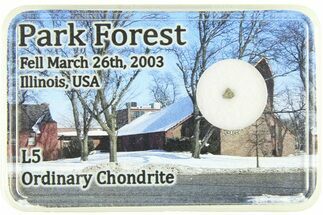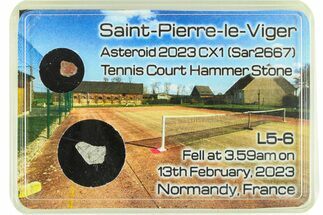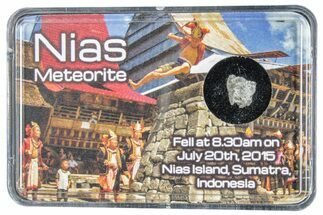This Specimen has been sold.
Park Forest Meteorite Fragments (0.06 g) - 2003 Illinois Fall
This is a collection of fragments from the L5 chondrite known as Park Forest, which fell over the village of the same name in Illinois on March 26, 2003.
These specimens come in thier own labeled display case.
These specimens come in thier own labeled display case.
At nearly midnight on March 26, 2003, witnesses in Illinois, Indiana, and Ohio saw a bright fireball streak across the sky. Seconds later, the village of Park Forest in Cook County, Illinois was showered by numerous small stones: two houses were struck as well as the first station! Over the next few days, about 18 total kilograms of material were recovered, including a main mass of about 3 kilograms. The meteorite was dubbed Park Forest after its landing site.
Park Forest is an L5 ordinary chondrite with a brecciated texture. Some fragments display dark veins likely caused by impact melt, and many pieces are partially to fully fusion crusted. Chondrules are not usually present, but fragments often contain troilite and other metals.
Park Forest is an L5 ordinary chondrite with a brecciated texture. Some fragments display dark veins likely caused by impact melt, and many pieces are partially to fully fusion crusted. Chondrules are not usually present, but fragments often contain troilite and other metals.
What Is An L5 Chondrite?
An L5 chondrite is a type of stony meteorite that falls under the "L" (low iron) chondrite group. L chondrites have lower iron content (around 7-11% iron, mostly in the form of iron sulfide or silicates) and typically show less metal than H chondrites (high iron chondrites). They primarily consist of silicate minerals like olivine and pyroxene.
The "5" rating indicates a high degree of thermal metamorphism. This means that the L5 chondrite experienced substantial heating, likely on its parent asteroid, which caused partial recrystallization of minerals. As a result, the original chondrules (small, rounded particles) are less distinct and partially altered, though still visible. L5 chondrites usually have a light to medium gray matrix, and the chondrules tend to be less clearly defined due to metamorphic alteration. You may still see rounded chondrule outlines, but they appear partially integrated with the surrounding matrix.
The L chondrite group is believed to come from a specific parent body in the asteroid belt, which likely experienced a major collisional event. This event may have sent large quantities of L chondritic material into space, resulting in the abundance of L chondrites found on Earth.
An L5 chondrite is a type of stony meteorite that falls under the "L" (low iron) chondrite group. L chondrites have lower iron content (around 7-11% iron, mostly in the form of iron sulfide or silicates) and typically show less metal than H chondrites (high iron chondrites). They primarily consist of silicate minerals like olivine and pyroxene.
The "5" rating indicates a high degree of thermal metamorphism. This means that the L5 chondrite experienced substantial heating, likely on its parent asteroid, which caused partial recrystallization of minerals. As a result, the original chondrules (small, rounded particles) are less distinct and partially altered, though still visible. L5 chondrites usually have a light to medium gray matrix, and the chondrules tend to be less clearly defined due to metamorphic alteration. You may still see rounded chondrule outlines, but they appear partially integrated with the surrounding matrix.
The L chondrite group is believed to come from a specific parent body in the asteroid belt, which likely experienced a major collisional event. This event may have sent large quantities of L chondritic material into space, resulting in the abundance of L chondrites found on Earth.
TYPE
L5 Chondrite
LOCATION
Park Forest, Illinois
SIZE
Total Mass: .06 grams
CATEGORY
ITEM
#285555
 Reviews
Reviews












